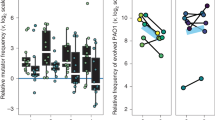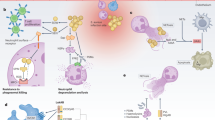Abstract
Identifying genes required by pathogens during infection is critical for antimicrobial development. Here, we use a Monte Carlo simulation-based method to analyse high-throughput transposon sequencing data to determine the role of infection site and co-infecting microorganisms on the in vivo ‘essential’ genome of Staphylococcus aureus. We discovered that co-infection of murine surgical wounds with Pseudomonas aeruginosa results in conversion of ∼25% of the in vivo S. aureus mono-culture essential genes to non-essential. Furthermore, 182 S. aureus genes are uniquely essential during co-infection. These ‘community dependent essential’ (CoDE) genes illustrate the importance of studying pathogen gene essentiality in polymicrobial communities.
This is a preview of subscription content, access via your institution
Access options
Access Nature and 54 other Nature Portfolio journals
Get Nature+, our best-value online-access subscription
$29.99 / 30 days
cancel any time
Subscribe to this journal
Receive 12 digital issues and online access to articles
$119.00 per year
only $9.92 per issue
Buy this article
- Purchase on Springer Link
- Instant access to full article PDF
Prices may be subject to local taxes which are calculated during checkout


Similar content being viewed by others
References
Lewis, K. Nat. Rev. Drug Discov. 12, 371–387 (2013).
Le Breton, Y. et al. Sci. Rep. 5, 9838 (2015).
Turner, K. H., Wessel, A. K., Palmer, G. C., Murray, J. L. & Whiteley, M. Proc. Natl Acad. Sci. USA 112, 4110–4115 (2015).
Umland, T. C. et al. mBio 3, e00113-12 (2012).
van Opijnen, T. & Camilli, A. Nat. Rev. Microbiol. 11, 435–442 (2013).
Turner, K. H. et al. PLoS Genet. 10, e1004518 (2014).
Valentino, M. D. et al. mBio 5, e01729-14 (2014).
Wilde, A. D. et al. PLoS Pathog. 11, e1005341 (2015).
Stacy, A., McNally, L., Darch, S. E., Brown, S. P. & Whiteley, M. Nat. Rev. Microbiol. 14, 93–105 (2015).
Chambers, H. F. & Deleo, F. R. Nat. Rev. Microbiol. 7, 629–641 (2009).
Lowy, F. D. N. Engl. J. Med. 339, 520–532 (1998).
Cheng, A. G., DeDent, A. C., Schneewind, O. & Missiakas, D. Trends Microbiol. 19, 225–232 (2011).
Gjødsbøl, K. et al. Int. Wound J. 3, 225–231 (2006).
Madsen, S. M., Westh, H., Danielsen, L. & Rosdahl, V. T. APMIS 104, 895–899 (1996).
Powell, J. E., Leonard, S. P., Kwong, W. K., Engel, P. & Moran, N. A. Proc. Natl Acad. Sci. USA 113, 13887–13892 (2016).
Zomer, A., Burghout, P., Bootsma, H. J., Hermans, P. W. & van Hijum, S. A. PLoS ONE 7, e43012 (2012).
Dalton, T. et al. PLoS ONE 6, e27317 (2011).
Korgaonkar, A., Trivedi U., Rumbaugh K. P. & Whiteley M. Proc. Natl Acad. Sci. USA 110, 1059–1064 (2013).
Fazli, M. et al. J. Clin. Microbiol. 47, 4084–4089 (2009).
Gottrup, F. Wound Repair Regen. 12, 129–133 (2004).
Anderson, M., Chen, Y. H., Butler, E. K. & Missiakas, D. M. J. Bacteriol. 193, 1583–1589 (2011).
Cao, Z., Casabona, M. G., Kneuper, H., Chalmers, J. D. & Palmer, T. Nat. Microbiol. 2, 16183 (2016).
Sun, Y., Dowd, S. E., Smith, E., Rhoads, D. D. & Wolcott, R. D. Wound Repair Regen. 16, 805–813 (2008).
DeLeon, S. et al. Infect. Immun. 82, 4718–4728 (2014).
Welch, M. J. L., Rossetti, B. J., Rieken, C. W., Dewhirst, F. E. & Borisy, G. G. Proc. Natl Acad. Sci. USA 113, E791–E800 (2016).
Ramsey, M. M., Rumbaugh, K. P., Whiteley, M. & Sullam, P. M. PLoS Pathog. 7, e1002012 (2011).
Stacy, A., Fleming, D., Lamont, R. J., Rumbaugh, K. P. & Whiteley, M. mBio 7, e00782-16 (2016).
Gallagher, L. A., Shendure, J. & Manoil, C. mBio 2, e00315-10 (2011).
Olson, M. E. in The Genetic Manipulation of Staphylococci 69–74 (Springer, 2015).
Zhang, X. et al. PLoS Genet. 8, e1002804 (2012).
Reyes, O. et al. Gene 107, 61–68 (1991).
Ferrieres, L. et al. J. Bacteriol. 192, 6418–6427 (2010).
Mintz, K. P. Microbiology 150, 2677–2688 (2004).
Watters, C. et al. Med. Microbiol. Immunol. 202, 131–141 (2013).
Murray, J. L., Kwon, T., Marcotte, E. M. & Whiteley, M. mBio 6, e01603-15 (2015).
Klein, B. A. et al. BMC Genomics 13, 578 (2012).
Martin, M. EMBnet 17, 10–12 (2011).
Love, M. I., Huber, W. & Anders, S. Genome Biol. 15, 550 (2014).
Fraley, C. & Raftery, A. E. J. Am. Stat. Assoc. 97, 611–631 (2002).
Oliveros, J. C. VENNY. An interactive tool for comparing lists with Venn's diagrams (BioinfoGP, 2007–2015); http://bioinfogp.cnb.csic.es/tools/venny/index.html
Schindelin, J. et al. Nat. Methods 9, 676–682 (2012).
Acknowledgements
This work was supported by the National Institutes of Health (NIH, grants R01GM116547-01A1 and 1R01DE023193-01 to M.W.) and a grant from Human Frontiers Science (to M.W.). C.B.I. is supported by postdoctoral fellowship IBBERS16F0 from the Cystic Fibrosis Foundation. Contributions by M.S.G. were supported by PHS grant AI107248 and the Harvard-wide Program on Antibiotic Resistance (AI083214). A.S. is supported by a predoctoral fellowship from the NIH (F31DE024931). The authors thank M. Ramsey for generating pMR361-K, K. Michie for assistance with the chronic surgical wound experiments, S. Leonard for computational assistance and D. Cornforth for discussion of the manuscript.
Author information
Authors and Affiliations
Contributions
C.B.I., A.S., K.R. and M.W. designed experiments. C.B.I., A.S. and M.W. analysed data. C.B.I., A.S. and D.F. performed experiments. J.L.D. prepared sequencing libraries. M.S.G. provided S. aureus HG003 transposon library and provided the raw data from previous studies7,8 included in the analysis. C.B.I., A.S., J.L.D., M.S.G., K.R. and M.W. wrote the paper.
Corresponding author
Ethics declarations
Competing interests
The authors declare no competing financial interests.
Supplementary information
Supplementary information
Supplementary Figures 1–3, Supplementary Tables 2 and 3, Supplementary References (PDF 766 kb)
Supplementary Table 1
The essential genes for S. aureus and A. actinomycetemcomitans. (XLSX 851 kb)
Supplementary Table 4
Sequencing data for each replicate in this study. (XLSX 9 kb)
Supplementary Table 5
A list of all of the ‘TA’ dinucleotide positions in the S. aureus NCTC8325 reference genome. (XLSX 2454 kb)
Supplementary Table 6
A list of all of the ‘TA’ dinucleotide positions in the A. actinomycetemcomitans strain 624 reference genome. (XLSX 1259 kb)
Supplementary Table 7
Homologues in S. aureus strain NCTC8325 and S. aureus strain USA300_FPR3757 for the transposon mutants used in this study. (XLSX 48 kb)
Rights and permissions
About this article
Cite this article
Ibberson, C., Stacy, A., Fleming, D. et al. Co-infecting microorganisms dramatically alter pathogen gene essentiality during polymicrobial infection. Nat Microbiol 2, 17079 (2017). https://doi.org/10.1038/nmicrobiol.2017.79
Received:
Accepted:
Published:
DOI: https://doi.org/10.1038/nmicrobiol.2017.79
This article is cited by
-
Formation of a biofilm matrix network shapes polymicrobial interactions
The ISME Journal (2023)
-
The biogeography of infection revisited
Nature Reviews Microbiology (2022)
-
Synthetic microbial communities of heterotrophs and phototrophs facilitate sustainable growth
Nature Communications (2020)
-
Inhibition of the ATP synthase sensitizes Staphylococcus aureus towards human antimicrobial peptides
Scientific Reports (2020)
-
A decade of advances in transposon-insertion sequencing
Nature Reviews Genetics (2020)



